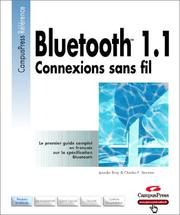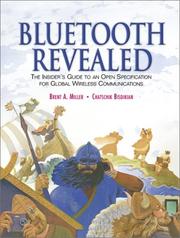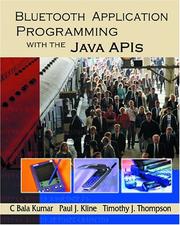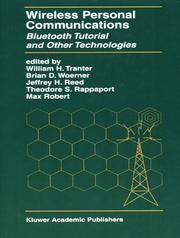| Listing 1 - 10 of 20 | << page >> |
Sort by
|

ISBN: 2744014419 Year: 2002 Publisher: Paris : CampusPress,
Abstract | Keywords | Export | Availability | Bookmark
 Loading...
Loading...Choose an application
- Reference Manager
- EndNote
- RefWorks (Direct export to RefWorks)
Book
ISBN: 1484266587 1484266579 Year: 2021 Publisher: New York : Apress,
Abstract | Keywords | Export | Availability | Bookmark
 Loading...
Loading...Choose an application
- Reference Manager
- EndNote
- RefWorks (Direct export to RefWorks)

ISBN: 0130902942 9780130902948 Year: 2001 Publisher: Upper Saddle River, NJ : PTR Prentice Hall,
Abstract | Keywords | Export | Availability | Bookmark
 Loading...
Loading...Choose an application
- Reference Manager
- EndNote
- RefWorks (Direct export to RefWorks)
Bluetooth technology --- Telecommunication --- Computer network protocols --- Bluetooth (Technologie) --- Télécommunications --- Protocoles de réseaux d'ordinateurs --- Equipment and supplies --- Equipement --- Bluetooth technology. --- Computer network protocols. --- Equipment and supplies. --- Télécommunications --- Protocoles de réseaux d'ordinateurs --- Telecommunication equipment and supplies

ISBN: 9781558609341 1558609342 9786611007263 1281007269 0080490530 9780080490533 Year: 2004 Publisher: Amsterdam ; Boston : Morgan Kaufmann Publishers,
Abstract | Keywords | Export | Availability | Bookmark
 Loading...
Loading...Choose an application
- Reference Manager
- EndNote
- RefWorks (Direct export to RefWorks)
Adoption of Bluetooth wireless technology has made great strides in the last few years. One of the biggest steps forward-the standardization of Java APIs for Bluetooth wireless technology (JABWT)-is explained in detail in this book. The JABWT standard, defined by the JSR-82 specification, supports rapid development of Bluetooth applications that are portable, secure, and highly-usable. Wireless device manufacturers have responded to the JABWT specification by announcing mobile phones and other products that will run JABWT applications. Bluetooth Application Programming with the Java APIs expla
Bluetooth technology. --- Java (Computer program language) --- Application program interfaces (Computer software) --- Wireless communication systems. --- Bluetooth (Technologie) --- Java (Langage de programmation) --- Interfaces de programmation d'applications --- Transmission sans fil --- Communication systems, Wireless --- Wireless data communication systems --- Wireless information networks --- Wireless telecommunication systems --- Telecommunication systems --- APIs (Computer software) --- Interfaces, Application program (Computer software) --- Application software --- Object-oriented programming languages --- JavaSpaces technology --- Wireless communication systems
Book
ISBN: 9783030886264 Year: 2022 Publisher: Cham Springer International Publishing :Imprint: Springer
Abstract | Keywords | Export | Availability | Bookmark
 Loading...
Loading...Choose an application
- Reference Manager
- EndNote
- RefWorks (Direct export to RefWorks)
Bluetooth technology. --- Modems. --- Internet of things. --- IoT (Computer networks) --- Things, Internet of --- Computer networks --- Embedded Internet devices --- Machine-to-machine communications --- Modulate/demodulate units --- Computer input-output equipment --- Data transmission systems --- Modulators (Electronics) --- Wireless communication systems

ISBN: 1280205601 9786610205608 0306469863 079237214X Year: 2001 Publisher: Boston : Kluwer Academic,
Abstract | Keywords | Export | Availability | Bookmark
 Loading...
Loading...Choose an application
- Reference Manager
- EndNote
- RefWorks (Direct export to RefWorks)
This volume presents a broad range of topics in wireless communications, including perspectives from both industry and academia. It serves as a reflection of emerging technologies in wireless communications and features papers from world-renowned authors on the subject. A new tutorial on the emerging Bluetooth technology is also presented. This book may be used as a text for advanced courses on the subject should serve as a useful reference tool for graduate students, postgraduate researchers, academics, and anyone working in the research aspect of the wireless communications industry.
Personal communication service systems. --- Bluetooth technology. --- Materials. --- Computer engineering. --- Materials Science, general. --- Electrical Engineering. --- Signal, Image and Speech Processing. --- Materials science. --- Electrical engineering. --- Signal processing. --- Image processing. --- Speech processing systems. --- Computational linguistics --- Electronic systems --- Information theory --- Modulation theory --- Oral communication --- Speech --- Telecommunication --- Singing voice synthesizers --- Pictorial data processing --- Picture processing --- Processing, Image --- Imaging systems --- Optical data processing --- Processing, Signal --- Information measurement --- Signal theory (Telecommunication) --- Electric engineering --- Engineering --- Material science --- Physical sciences --- Wireless communication systems --- PCS systems --- Personal telecommunication systems --- Personal wireless communication systems --- Personalized communication services --- Wireless personal communication systems
Book
Year: 2020 Publisher: Basel, Switzerland MDPI - Multidisciplinary Digital Publishing Institute
Abstract | Keywords | Export | Availability | Bookmark
 Loading...
Loading...Choose an application
- Reference Manager
- EndNote
- RefWorks (Direct export to RefWorks)
Bioelectric sensors are unique diagnostic principles and technologies. Although they share many traits with electrochemical sensors, especially regarding the common features of instrumentation, they are focused on the measurement of the electric properties of biorecognition elements as a reflection of cellular, biological, and biomolecular functions in a rapid, very sensitive, and often non-invasive manner. Bioelectric sensors offer a plethora of options in terms both of assay targets (molecules, cells, organs, and organisms) and methodological approaches (e.g., potentiometry, impedance spectrometry, and patch-clamp electrophysiology). Irrespective of the method of choice, “bioelectric profiling” is being rapidly established as a superior concept for a number of applications, including in vitro toxicity, signal transduction, real-time medical diagnostics, environmental risk assessment, and drug development. This Special Issue is the first that is exclusively dedicated to the advanced and emerging concepts and technologies of bioelectric sensors. Topics include, but are not restricted to, bioelectric sensors for single cell analysis, electrophysiological olfactory and volatile organic compounds sensors, impedimetric biosensors, microbial fuel cell biosensors, and implantable autonomous bioelectric micro- and nano-sensors.
Technology: general issues --- organic optoelectronic device --- pulse meter --- biosensor --- Bluetooth low energy (BLE) --- photoplethysmogram (PPG) --- chronic wounds --- electrical stimulation --- direct microcurrent --- non-invasive --- pressure ulcer --- wireless technology --- biochips --- impedance spectroscopy --- electrical equivalent circuit --- biomaterial --- Lysinibacillus sphaericus JG-A12 --- anticancer therapeutic strategies --- apoptosis --- bioelectric --- 5-fluorouracil --- HeLa cell line --- superoxide --- cell immobilization --- 3D-printed well --- bioelectric profiling --- impedance analysis --- real-time measurements --- electrochemical biosensors --- SWCNT --- point-of-care diagnostics --- label-free biosensors --- ELISA --- carbon nanotubes --- bovine serum albumin --- pacemaker --- threat modeling --- internet of things (IoT) medical devices --- vulnerabilities --- n/a
Book
Year: 2021 Publisher: Basel, Switzerland MDPI - Multidisciplinary Digital Publishing Institute
Abstract | Keywords | Export | Availability | Bookmark
 Loading...
Loading...Choose an application
- Reference Manager
- EndNote
- RefWorks (Direct export to RefWorks)
People living in both developed and developing countries face serious health challenges related to sedentary lifestyles. It is therefore essential to find new ways to improve health so that people can live longer and can age well. With an ever-growing number of smart sensing systems developed and deployed across the globe, experts are primed to help coach people toward healthier behaviors. The increasing accountability associated with app- and device-based behavior tracking not only provides timely and personalized information and support but also gives us an incentive to set goals and to do more. This book presents some of the recent efforts made towards automatic and autonomous identification and coaching of troublesome behaviors to procure lasting, beneficial behavioral changes.
Technology: general issues --- activity recognition --- wearable devices --- inertial sensors --- Bluetooth beacons --- machine learning --- e-coaching --- m-health intervention --- personalization --- healthy lifestyle --- physical activity --- tangible user interface --- affordance --- multimodal cueing --- animate objects --- activities of daily living --- human activity recognition --- context-awareness --- Bayesian network --- mobile application --- wearable computing --- wrist-worn heart rate devices --- cardiac rehabilitation --- real-time wearable monitoring --- fuzzy logic --- fuzzy linguistic approach --- m-health --- remote coaching --- telemonitoring --- telehealth --- cadence --- marathon --- elevation change analysis --- personalized assistance level --- coaching --- electric bicycles --- ubiquitous computing --- health --- human-centered computing --- digital coaching --- diabetes education --- serious gaming --- self-management --- user evaluations --- sedentary lifestyle --- context recognition --- unhealthy sitting habits --- wearable sensors --- smartphones --- smart objects --- behavior change
Book
ISSN: 21915768 ISBN: 3642406459 3642406467 Year: 2013 Publisher: New York : Springer,
Abstract | Keywords | Export | Availability | Bookmark
 Loading...
Loading...Choose an application
- Reference Manager
- EndNote
- RefWorks (Direct export to RefWorks)
Bluetooth technology has enjoyed tremendous success, and it's now employed in billions of devices for short-range wireless data and real-time audio or video transfer. In this book the authors provide an overview of Bluetooth security. They examine network vulnerabilities and provide a literature-review comparative analysis of recent security attacks. They analyze and explain related countermeasures, including one based on secure simple pairing, and they also propose a novel attack that works against all existing Bluetooth versions. They conclude with a discussion on future research directions. The book is appropriate for practitioners and researchers in information security, in particular those engaged in the design of networked and mobile devices.
Bluetooth technology -- Security measures. --- Engineering & Applied Sciences --- Electrical & Computer Engineering --- Computer Science --- Telecommunications --- Bluetooth technology --- Security measures. --- Computer science. --- Computer communication systems. --- Computer security. --- Data structures (Computer science). --- System safety. --- Computer Science. --- Data Structures, Cryptology and Information Theory. --- Systems and Data Security. --- Computer Communication Networks. --- Security Science and Technology. --- Wireless communication systems --- Data structures (Computer scienc. --- Data Structures and Information Theory. --- Data structures (Computer science) --- Information structures (Computer science) --- Structures, Data (Computer science) --- Structures, Information (Computer science) --- Electronic data processing --- File organization (Computer science) --- Abstract data types (Computer science) --- Computer privacy --- Computer system security --- Computer systems --- Computers --- Cyber security --- Cybersecurity --- Electronic digital computers --- Protection of computer systems --- Security of computer systems --- Data protection --- Security systems --- Hacking --- Protection --- Security measures --- Safety, System --- Safety of systems --- Systems safety --- Accidents --- Industrial safety --- Systems engineering --- Communication systems, Computer --- Computer communication systems --- Data networks, Computer --- ECNs (Electronic communication networks) --- Electronic communication networks --- Networks, Computer --- Teleprocessing networks --- Data transmission systems --- Digital communications --- Electronic systems --- Information networks --- Telecommunication --- Cyberinfrastructure --- Network computers --- Prevention --- Distributed processing --- Computer networks
Book
Year: 2021 Publisher: Basel, Switzerland MDPI - Multidisciplinary Digital Publishing Institute
Abstract | Keywords | Export | Availability | Bookmark
 Loading...
Loading...Choose an application
- Reference Manager
- EndNote
- RefWorks (Direct export to RefWorks)
In recent years, rapid development in robotics, mobile, and communication technologies has encouraged many studies in the field of localization and navigation in indoor environments. An accurate localization system that can operate in an indoor environment has considerable practical value, because it can be built into autonomous mobile systems or a personal navigation system on a smartphone for guiding people through airports, shopping malls, museums and other public institutions, etc. Such a system would be particularly useful for blind people. Modern smartphones are equipped with numerous sensors (such as inertial sensors, cameras, and barometers) and communication modules (such as WiFi, Bluetooth, NFC, LTE/5G, and UWB capabilities), which enable the implementation of various localization algorithms, namely, visual localization, inertial navigation system, and radio localization. For the mapping of indoor environments and localization of autonomous mobile sysems, LIDAR sensors are also frequently used in addition to smartphone sensors. Visual localization and inertial navigation systems are sensitive to external disturbances; therefore, sensor fusion approaches can be used for the implementation of robust localization algorithms. These have to be optimized in order to be computationally efficient, which is essential for real-time processing and low energy consumption on a smartphone or robot.
Technology: general issues --- Energy industries & utilities --- dynamic objects identification and localization --- laser cluster --- radial velocity similarity --- Pearson correlation coefficient --- particle filter --- trilateral indoor positioning --- RSSI filter --- RSSI classification --- stability --- accuracy --- inertial navigation system --- artificial neural network --- motion tracking --- sensor fusion --- indoor navigation system --- indoor positioning --- indoor navigation --- radiating cable --- leaky feeder --- augmented reality --- Bluetooth --- indoor positioning system --- smart hospital --- indoor --- positioning --- visually impaired --- deep learning --- multi-layered perceptron --- inertial sensor --- smartphone --- multi-variational message passing (M-VMP) --- factor graph (FG) --- second-order Taylor expansion --- cooperative localization --- joint estimation of position and clock --- RTLS --- indoor positioning system (IPS) --- position data --- industry 4.0 --- traceability --- product tracking --- fingerprinting localization --- Bluetooth low energy --- Wi-Fi --- performance metrics --- positioning algorithms --- location source optimization --- fuzzy comprehensive evaluation --- DCPCRLB --- UAV --- unmanned aerial vehicles --- NWPS --- indoor positioning systems --- GPS denied --- GNSS denied --- autonomous vehicles --- visible light positioning --- mobile robot --- calibration --- appearance-based localization --- computer vision --- Gaussian processes --- manifold learning --- robot vision systems --- image manifold --- descriptor manifold --- indoor fingerprinting localization --- Gaussian filter --- Kalman filter --- received signal strength indicator --- channel state information --- indoor localization --- visual-inertial SLAM --- constrained optimization --- path loss model --- particle swarm optimization --- beacon --- absolute position system --- cooperative algorithm --- intercepting vehicles --- robot framework --- UWB sensors --- Internet of Things (IoT) --- wireless sensor network (WSN) --- switched-beam antenna --- electronically steerable parasitic array radiator (ESPAR) antenna --- received signal strength (RSS) --- fingerprinting --- down-conversion --- GPS --- navigation --- RF repeaters --- up-conversion --- n/a
| Listing 1 - 10 of 20 | << page >> |
Sort by
|

 Search
Search Feedback
Feedback About UniCat
About UniCat  Help
Help News
News